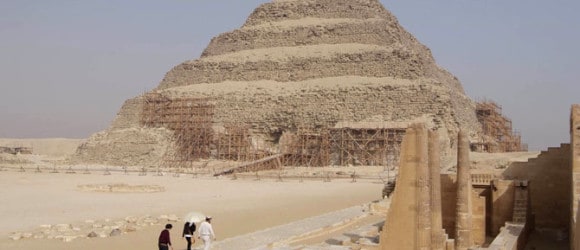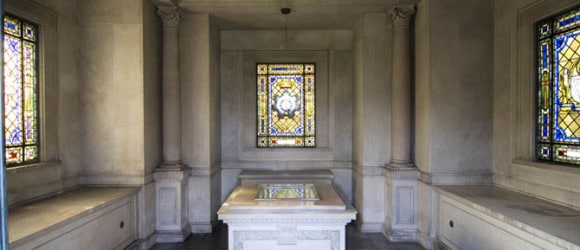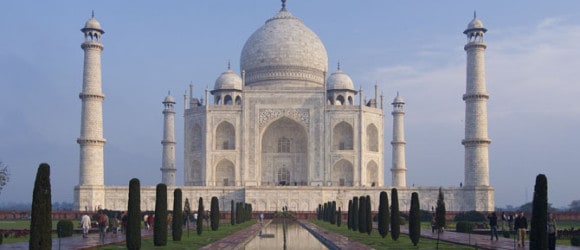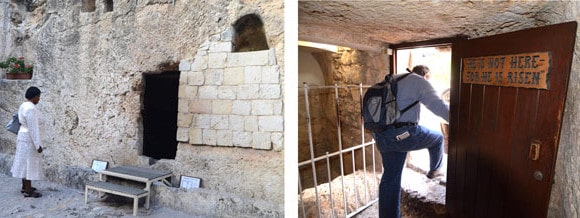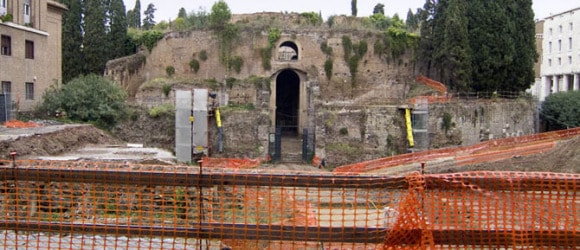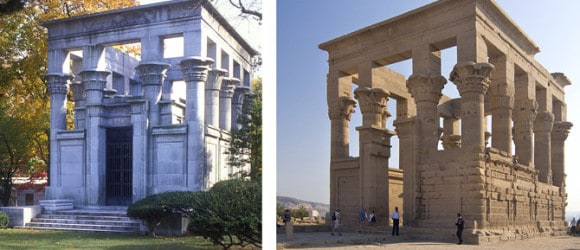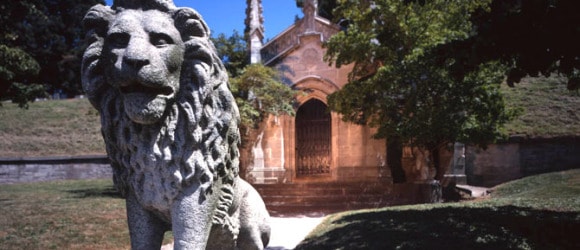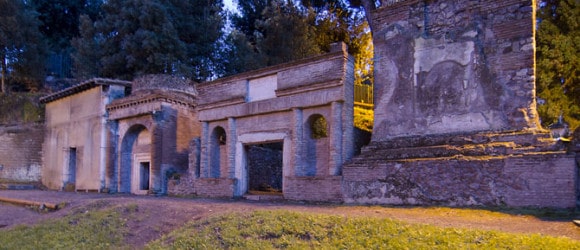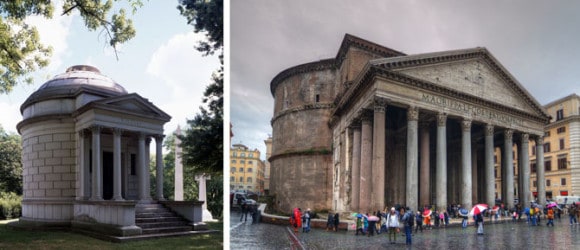The Urban Mausoleum
- At October 19, 2013
- By mausoleum
- In Doug Keister's Blog
 0
0
It is a common, but understandable, misconception that cemeteries in large urban areas like New York City no longer have space available for constructing new private mausoleums.
Read More»Built for Eternity
- At August 06, 2013
- By mausoleum
- In Doug Keister's Blog
 0
0
Before my book on mausoleums Going Out in Style: The Architecture of Eternity was published in 1997, I was known as “America’s most noted photographer of historic architecture.” My title was due in large part to three books on Victorian architecture, two books on Arts and Crafts architecture and numerous magazine assignments documenting historic architecture inside and out. My interest in funerary art and architecture, and mausoleums in particular, was a natural progression. Mausoleums, to put it simply, are the most unspoiled resource of historic architecture. If you want to see pure examples of a style of architecture, journey to a cemetery and study its mausoleums.
Unlike residences and commercial buildings that usually have a finite lifespan, mausoleums are essentially built for eternity. In the course of my architectural studies, I decided to research the age of the oldest buildings in the world. Scholars may debate what constitutes a building, but the oldest man-built structure in the world is generally recognized as Barnenez, a “passage grave” in what is now the Brittany region of northern France. Barnenez dates to around 4850 BC.
Read More»Inside the Chapel
- At August 15, 2013
- By mausoleum
- In Doug Keister's Blog
 0
0
The most most preferred mausoleum building material is granite. That is certainly the way it should be. When building for eternity, practically nothing outlasts granite. It is a good choice for mausoleum exteriors because of its durability and hardness as well as its uniform color.
When selecting materials for mausoleum interiors, especially chapel mausoleums, other not-as-durable materials may be worth considering. While marble may not age well in the weather, it often works well on interiors, especially when a range of textures and colors is desired. The same goes for other masonry materials such as limestone. Marble, of course, has been the preferred material for sculpture, but it is best used when the sculpture is indoors. Again, granite trumps marble for exterior use.
Read More»The Taj Mahal: A Tomb For Two For Love
- At August 12, 2013
- By mausoleum
- In Doug Keister's Blog
 0
0
We’ve all heard the line before: You’ve gotta go see a certain movie, a tourist site, a cathedral, a … well… insert whatever it may be. What often happens? You see/hear/experience whatever it may be, and you think, “Well that was nice, but it didn’t really knock my socks off.” I think I’d rather hear from someone, “Hey, why don’t you check out (insert item here), I think you might like it.” Then at least my expectations aren’t too high.
However, if you ever get a chance to see the Taj Mahal in person, go! It is truly SPECTACULAR. Not only is it one of the most recognizable buildings in the world, it is also a mausoleum. A tomb built for two.
Read More»In Search of Jesus’ Tomb
- At August 16, 2013
- By mausoleum
- In Doug Keister's Blog
 0
0
It is probably next to impossible to precisely plumb what tomb people most want to see. The Taj Mahal and the Great Pyramid of Giza are certainly contenders. But the majority of people do not go to those places because they want to see a tomb. They go there because of the history and architecture.
However, there is one burial place where people go specifically to see a tomb. The name of the person who supposedly occupied this tomb just might be the most recognizable name on Earth: Jesus of Nazareth.
Travelers to the Holy Land often hear the phrase ‘the tradition is.’ There are so many layers of history, buildings, events, and people that the whereabouts of specific historic sites have been lost to the ages. To be sure, the Mount of Olives, Garden of Gethsemane, the Sea of Galilee, the Jordan River, and Mount Zion are verifiable places. But other places are often referred to as the ‘traditional site’ such as the traditional site of the Last Supper and the traditional site of Jesus’ birth. Other sites have more than one traditional location. Such is the case with Mary’s place of ascension and Jesus’ tomb and place of ascension.
Read More»2000 Year Old Mausoleum to Receive $3 Million for Restoration in Creative Trade
- At October 23, 2014
- By mausoleum
- In Doug Keister's Blog
 0
0
I can’t count the number of times that, when I tell people about my appreciation of mausoleums and cemeteries, I hear, “What a waste of money. What are they good for? People ought to be assigning money in their wills toward art and things that benefit humanity.”
After they have finished their all-things-funerary diatribe, I pause to collect my thoughts. Then, with one eye closed and eyebrow raised, I ask them what they think about the Pyramids of Egypt, the Taj Mahal in India, the Terra-cotta Warriors in China, Westminster Abbey in England, and the Pantheon in Rome.
As I continue to rattle off well-known mausoleums and burial locations around the world, they usually hold up their hand imploring me to stop. They get my point. The fact is many of the most popular tourist destinations in the world are mausoleums. They are not only a testament to the entombed person but timestamps that often tell us, in great detail, what the architectural and social mores were at the time they were constructed.
The latest permutation of the staying power of mausoleums is that one of them has now become a bargaining chip: the restoration of the Mausoleum of Augustus in Rome for art. Augustus was the first emperor of Rome. He ruled as emperor for 41 years, dying at age 75 in 14 AD.
Read More»Seeing Double: Bache Mausoleum borrows from Kiosk of Trajan
To coin a phrase, “if it works, don’t fix it.” The design of most mausoleums, like houses, is based on tried and true templates. And there are, of course, personal visions, one-of-a-kind mausoleums, that reflect the taste or whim of the designer or owner. There is a third inspiration for mausoleums: basing the design on existing buildings that may or may not be mausoleums. When designing a mausoleum, it is certainly worth considering using an existing building as inspiration. Indeed, if it works, don’t fix it.
Read More»Accessorize, Accessorize
- At October 25, 2014
- By mausoleum
- In Doug Keister's Blog
 0
0
Although there are a number of architectural and design styles differentiating mausoleums, designers add a little more pizzazz with architectural embellishments and statuary. The statuary can be inside or outside the mausoleum and, unlike mausoleums where granite is the preferred medium, statuary has a wide range of options.
Durable materials such as granite, marble, and bronze all have their attributes for mausoleum design and embellishment. Each material has its own intrinsic appeal, but the choice of material is essentially a matter of personal taste.
Marble, of course, has been long associated with classical ideals. Its inherent translucency exudes a depth not attainable with granite or bronze. It is also softer than granite or bronze and is easier to work with, especially when trying to simulate smooth human skin. But its softness is also a magnet for stains and the ravages of acid rain.
Read More»The City of the Dead in a City of the Dead
- At May 13, 2014
- By mausoleum
- In Doug Keister's Blog
 0
0
Pompeii’s Mausoleums Provide the First Glimpse of the City
Mausoleums make great time capsules, mirroring the styles and traditions of the cultures that create them. Nowhere is that more evident than Pompeii, a city of the dead.
The citizens of Pompeii had plenty of warning signs they were sitting on the edge of the time bomb Mt. Vesuvius. In 62 C.E., a small earthquake rattled the town. Seventeen years later, in 79 C.E., fissures opened and steam poured out of the cracks. A few days later, pent-up gasses exploded, raining down rock and ash all over the city and prompting over 18,000 of Pompeii’s citizens to flee. Fifteen hundred people were left behind — those who either chose to stay or couldn’t escape fast enough. Staying proved to be a fatal error. Every one of the 1500 perished.
The 79 C.E. eruption of Mt. Vesuvius buried Pompeii in a thick layer of volcanic ash (tephra) approximately 75 feet deep and put a timestamp on what life was like in a small Roman town in the autumn of 79. Pompeii became an architectural and historical treasure trove.
Read More»Family Mausoleums Afford Opportunities to Channel Inspiration
- At May 09, 2014
- By mausoleum
- In Doug Keister's Blog
 0
0
“Genius,” Thomas Edison famously said, “is 1% inspiration and 99% perspiration.” That quote is often morphed into success is 1% inspiration and 99% perspiration and the various percentages of inspiration and perspiration have been altered as well. But the message is clear: under the visible tip (inspiration) of the iceberg of invention is an enormous foundation of hard work. While that is almost always true, what history remembers is the final result and not the effort that it took to achieve it.
To be sure, constructing a mausoleum requires substantial amounts of perspiration, not only by those building it, but by the person funding it. But, again, it is the result that is enduring. To coin another famous quote “God is in the detail.” In other words, if you are going to expend a lot of energy and resources, it’s worth taking time to make some inspired choices.
So where does one look for inspiration when designing a mausoleum? Certainly, there are a number of perfectly appropriate mausoleums that come pre-designed. Most of these designs are based on classical architecture principals and have, since the middle of the 18th century, been a staple of most architects’ palettes.
Read More»
